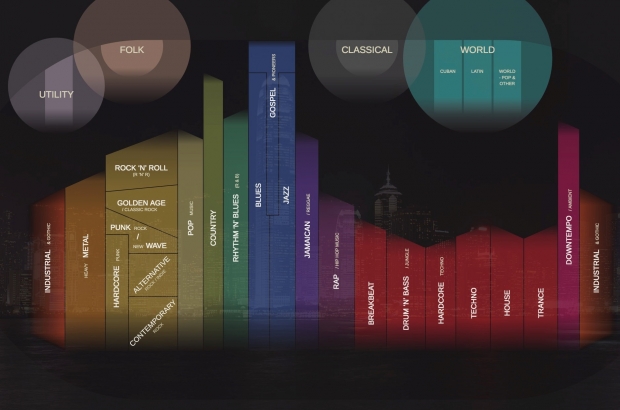- Daily & Weekly newsletters
- Buy & download The Bulletin
- Comment on our articles
From post-punk to trap-step: 146 years of music in one clickable map
Do you ever rock around your house to the sounds of new jack swing, but find yourself craving some unfamiliar tunes? Or perhaps you’re into music theory and spend evenings pondering on the connection between post-punk and new wave?
There’s now a place for all your needs. Musicmap is a visual reference that traces the history of every genre of popular music, from 1880 to the present.
At first glance, the website looks like a color-coded bar graph, with each column representing the dominant genres, from blues and jazz to rock’n’roll and folk. Zoom in, and the bars turn into an intricate web linking the countless subgenres, from the familiar Britpop and garage rock to the more ambiguous metalcore and reggaetón.
A click on the subgenre reveals a concise textual overview that places the music style in the social context in which it was born. There is also a brief playlist containing the genre’s most iconic tracks.
The service is the brainchild of Flemish architect Kwinten Crauwels, who spent eight years working on it. “I’ve always had very diverse taste in music and its many genres,” he says. “I’ve looked for a website that would provide a complete and balanced overview of popular music, but I never found it. There are a lot of noteworthy attempts, but most of them focus on specific genres, like rock or electro. So I decided to make one myself.”
A musical undertaking
But what is an architect doing creating such extensive project devoted to music? “It’s a question I get asked all the time,” he says. “It started as a kind of experiment, a hobby that just got out of hand. Throughout the years, Musicmap grew organically. In the beginning, I didn't even know what it would look like.”
Creating a comprehensive interactive map of music history required a lot of research. “I spent hours at the library or on the internet,” Crauwels says. “The most important thing was to limit the scope and focus on the essence. Otherwise, it would have taken a lifetime.”
From the get go, Musicmap was intended as a chart, but Crauwels imagined it to be a printable poster. “It was my brother who convinced me to create a website,” he explains. “In the course of eight years, the technology for projecting online data visually has grown immensely. Still, I never anticipated that Musicmap would become what it is now – with all the text and playlists.”
The website, he continues, has room to grow. “Differentiating between music genres in not an exact science. There is still room for improvement, but I'm very happy with the result.”
He describes Musicmap as an easy to use, comprehensive and interactive database that’s accessible and encyclopaedic at the same time. “The genres are defined in such a way that everyone can understand what they are and where they come from. This is what makes Musicmap unique.”
Lost in music
The project has received worldwide attention. “It’s nice to see the different ways in which music appeals to people, be it in Belgium or in Japan. From the reaction I get, it is clear that Musicmap fulfils a need. This is something people have been waiting for.”
The website went online in July, but Crauwels’ ambitions lie further. “Building a community around Musicmap is an option, but this might be difficult,” he says. “Defining genres is a complex issue, and people tend to have very divergent opinions. Above all, Musicmap is a tool for discovering new music.”
The service has been compared with streaming services like Spotify, but Crauwels says Musicmap is different. “The total amount of music recorded continues to grow, and everything’s digital, so we need more intelligent ways of searching for it. Most of the services work with algorithms that suggest similar songs to the ones you already like. That works fine – and the algorithms are getting better and better – but it is a passive way of finding music, because you stay in the same genre.”
Musicmap, he says, is a welcome addition to these services. “It lets you discover genres that you might have never heard of. Musicmap is a journey without a starting point, an invitation to get lost in the immense and fascinating universe of popular music.”









